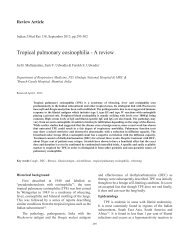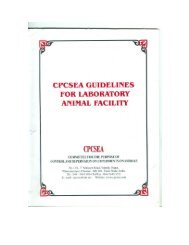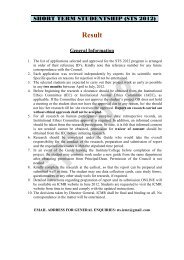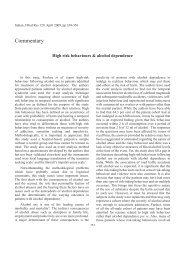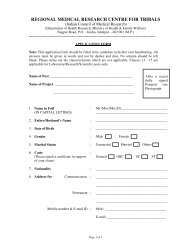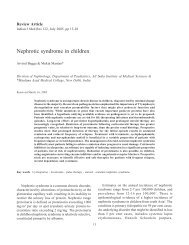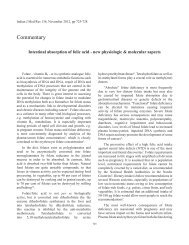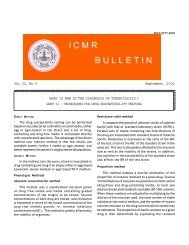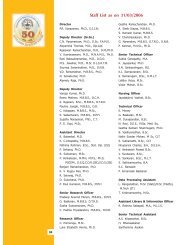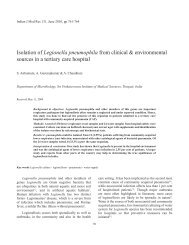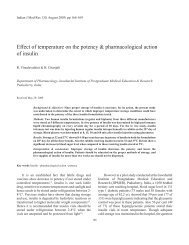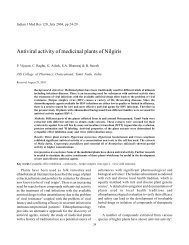India+ - Indian Council of Medical Research
India+ - Indian Council of Medical Research
India+ - Indian Council of Medical Research
Create successful ePaper yourself
Turn your PDF publications into a flip-book with our unique Google optimized e-Paper software.
Status Report<br />
<strong>Indian</strong> J Med Res 134, September 2011, pp 281-294<br />
Rationalizing antibiotic use to limit antibiotic resistance<br />
in India +<br />
Global Antibiotic Resistance Partnership (GARP) - India Working Group*<br />
Received August 10, 2011<br />
Antibiotic resistance, a global concern, is particularly pressing in developing nations, including India,<br />
where the burden <strong>of</strong> infectious disease is high and healthcare spending is low. The Global Antibiotic<br />
Resistance Partnership (GARP) was established to develop actionable policy recommendations<br />
specifically relevant to low- and middle-income countries where suboptimal access to antibiotics - not<br />
a major concern in high-income countries - is possibly as severe a problem as is the spread <strong>of</strong> resistant<br />
organisms. This report summarizes the situation as it is known regarding antibiotic use and growing<br />
resistance in India and recommends short and long term actions. Recommendations aim at (i) reducing<br />
the need for antibiotics; (ii) lowering resistance-enhancing drug pressure through improved antibiotic<br />
targeting, and (iii) eliminating antibiotic use for growth promotion in agriculture. The highest priority<br />
needs to be given to (i) national surveillance <strong>of</strong> antibiotic resistance and antibiotic use - better information<br />
to underpin decisions on standard treatment guidelines, education and other actions, as well as to monitor<br />
changes over time; (ii) increasing the use <strong>of</strong> diagnostic tests, which necessitates behavioural changes<br />
and improvements in microbiology laboratory capacity; (iii) setting up and/or strengthening infection<br />
control committees in hospitals; and (iv) restricting the use <strong>of</strong> antibiotics for non-therapeutic uses in<br />
agriculture. These interventions should help to reduce the spread <strong>of</strong> antibiotic resistance, improve public<br />
health directly, benefit the populace and reduce pressure on the healthcare system. Finally, increasing the<br />
types and coverage <strong>of</strong> childhood vaccines <strong>of</strong>fered by the government would reduce the disease burden<br />
enormously and spare antibiotics.<br />
Key words Agriculture - antibiotic resistance - healthcare access - health policy - hospital-acquired infection - infection control -<br />
vaccination - veterinary use<br />
* Dr Nirmal K. Ganguly, National Institute <strong>of</strong> Immunology, New Delhi, and Chair, GARP - India Working Group; Dr N.K. Arora,<br />
INCLEN Trust International, New Delhi; Dr Sujith J. Chandy, Christian <strong>Medical</strong> College, Vellore; Dr Mohamed Nadeem Fairoze,<br />
Veterinary College, KVAFS University, Hebbal, Bangalore; Dr J.P.S. Gill, Guru Angad Dev Veterinary and Animal Sciences<br />
University (GADVASU), Ludhiana; Dr Usha Gupta, Delhi Society for Promotion <strong>of</strong> Rational Use <strong>of</strong> Drugs, Delhi; Dr Shah<br />
Hossain, National Centre for Disease Control, New Delhi; Dr Sadhna Joglekar, GSK Pharmaceuticals Ltd., Mumbai; Dr P.C. Joshi,<br />
University <strong>of</strong> Delhi, Delhi; Dr Manish Kakkar, Public Health Foundation <strong>of</strong> India, New Delhi; Dr Anita Kotwani, Vallabhbhai Patel<br />
Chest Institute, University <strong>of</strong> Delhi, Delhi; Dr Ashok Rattan, Fortis Clinical <strong>Research</strong> Ltd., Gurgaon; Dr H. Sudarshan, Karuna<br />
Trust, Bangalore; Dr Kurien Thomas, Christian <strong>Medical</strong> College, Vellore; Dr Chand Wattal, Sir Ganga Ram Hospital, New Delhi;<br />
Ms Alice Easton, Center for Disease Dynamics, Economics & Policy, New Delhi & Dr Ramanan Laxminarayan, Public Health Foundation<br />
<strong>of</strong> India, New Delhi.<br />
+ The full GARP - India report can be accessed at: www.cddep.org/publications.<br />
281
282 INDIAN J MED RES, SEPTEMBER 2011<br />
Introduction<br />
Antimicrobial resistance, a global problem, is<br />
particularly pressing in developing countries where the<br />
infectious disease burden is high and cost constrains<br />
the replacement <strong>of</strong> older antibiotics with newer, more<br />
expensive ones. Management <strong>of</strong> common and lethal<br />
bacterial infections has been critically compromised by<br />
the appearance and rapid spread <strong>of</strong> antibiotic-resistant<br />
bacteria. The Global Antibiotic Resistance Partnership<br />
(GARP) was established to begin the process <strong>of</strong><br />
developing actionable policy recommendations relevant<br />
to low- and middle-income countries. Multidisciplinary<br />
working groups in India, Kenya, South Africa, and<br />
Vietnam took up this challenge in 2009 and have<br />
surveyed the state <strong>of</strong> antibiotic use and resistance and<br />
related factors (cddep.org). In light <strong>of</strong> this evidence,<br />
working groups have begun to define a set <strong>of</strong> broad<br />
policy objectives. This report summarises the India<br />
Situation Analysis <strong>of</strong> 2011 - the most comprehensive<br />
survey <strong>of</strong> undertaken in India - and recommends next<br />
steps.<br />
The bacterial disease burden in India is among the<br />
highest in the world 1 ; consequently, antibiotics will<br />
play a critical role in limiting morbidity and mortality<br />
in the country. As a marker <strong>of</strong> disease burden, pneumonia<br />
causes an estimated 410,000 deaths in India each year 2 ,<br />
and it is the number-one killer <strong>of</strong> children 3 . Many <strong>of</strong><br />
these deaths occur because patients do not have access to<br />
life-saving antibiotics when and where these are needed.<br />
At the other extreme, antibiotics are used in situations<br />
where these cannot be expected to improve the patient’s<br />
condition, particularly as treatment for the common<br />
cold and uncomplicated cases <strong>of</strong> diarrhoea (which are<br />
appropriately treated with oral rehydration therapy).<br />
‘Drug selection pressure’ is the single most<br />
important factor in the evolution <strong>of</strong> drug resistance in<br />
bacteria. The reasons for drug pressure are multifactorial<br />
and involve both human and animal use. Although drug<br />
resistance is primarily a medical problem, the factors<br />
that influence the spread <strong>of</strong> resistance are ecological,<br />
epidemiological, cultural, social, and economic.<br />
Patients, physicians, veterinarians, and healthcare<br />
facilities and retailers - from large pharmacies to<br />
local drug sellers - have little motivation (economic<br />
or otherwise) to acknowledge the consequences <strong>of</strong><br />
their use <strong>of</strong> antibiotics on others, especially on future<br />
generations.<br />
Every time an antibiotic is used - whether<br />
appropriately or not, in human beings or in animals-<br />
the probability <strong>of</strong> the development and spread <strong>of</strong><br />
antibiotic-resistant bacteria is increased 4,5 . Antibiotic<br />
effectiveness is a globally shared resource and a<br />
shared responsibility. That responsibility is to maintain<br />
antibiotic effectiveness as long as possible, while<br />
allowing the maximum possible health benefits to<br />
accrue to the world’s population. The actions needed to<br />
achieve this goal cannot be decided globally. Each nation<br />
must adopt strategies tailored to its own conditions.<br />
The GARP working groups’ recommendations are<br />
based on an understanding <strong>of</strong> the underlying issues,<br />
and the proposed solutions are designed to work in the<br />
21 st century.<br />
CuRRenT SITuATIon In IndIA<br />
Rising antibiotic use<br />
Antibiotic use has been increasing steadily in<br />
recent years (Fig. 1). Between 2005 and 2009, the<br />
units <strong>of</strong> antibiotics sold increased by about 40 per cent.<br />
Increased sales <strong>of</strong> cephalosporins were particularly<br />
striking, with sales (in units sold) increasing by 60<br />
per cent over that five-year period, but some increase<br />
was seen in most antibiotic classes. In comparison, a<br />
pilot survey conducted at private retail pharmacies in<br />
2004 6 and a survey in the same areas in 2008 found<br />
increased use <strong>of</strong> cephalosporins, but decreased use <strong>of</strong><br />
macrolides 7 .<br />
The fact that antibiotic use is increasing is not,<br />
itself, indicative <strong>of</strong> a problem, but evidence from<br />
studies <strong>of</strong> prescribing patterns suggests that antibiotics<br />
are <strong>of</strong>ten used in inappropriate ways.<br />
Fig. 1. Units <strong>of</strong> antibiotics sold in India, by type.<br />
Source: Ref 8.
Resistance to antibiotics<br />
GARP - INDIA WORKING GROUP: ANTIBIOTIC USE & RESISTANCE IN INDIA 283<br />
Antibiotic resistance has been a low-priority area<br />
in most developing and many developed countries.<br />
Compared with the immediate challenges <strong>of</strong> HIV/<br />
AIDS, tuberculosis, malaria, pneumonia, and many<br />
other infectious diseases, the loss <strong>of</strong> antibiotics at<br />
some future time does not capture the same attention.<br />
Resistance against certain antibiotics is already at high<br />
levels in certain places in India (and around the world),<br />
but the problem has remained largely unknown because<br />
relatively few studies were published and nationwide<br />
surveillance was not being carried out. But the issue<br />
came to the fore in India when New Delhi metalloß-lactamase-1<br />
(NDM-1), first reported in 2009, made<br />
front-page news in 2010.<br />
Briefly, NDM-1 is an enzyme produced by the<br />
gene bla NDM-1; it is named for New Delhi because<br />
the Swedish patient in whom it was first identified<br />
had undergone surgery in a New Delhi hospital 9 .<br />
The gene was carried on plasmids and could be<br />
transferred between different bacterial species, in this<br />
case between Klebsiella pneumoniae and Escherichia<br />
coli, and most importantly, conferred broad resistance<br />
to most antibiotics, including carbapenems. Later<br />
studies reported NDM-1 in a tertiary-care centre in<br />
Mumbai 10 . The controversy heated up when a paper<br />
appeared reporting the gene in multidrug-resistant<br />
Enterobacteriaceae in hospitals in Chennai and<br />
Haryana and in isolates from patients represented in the<br />
UK’s National Reference Library (a high percentage<br />
<strong>of</strong> whom had travelled to the subcontinent) 11 . A further<br />
study in which NDM-1 was detected in drinking water<br />
and seepage water in New Delhi 12 added to the concern<br />
and the focus on India - whether deserved or not.<br />
NDM-1 may be the most widely known form <strong>of</strong><br />
antibiotic resistance in India, but a number <strong>of</strong> studies<br />
in recent years have documented significant rates <strong>of</strong><br />
resistance to a wide range <strong>of</strong> antibiotics 13-30 . Many<br />
are <strong>of</strong> hospital-acquired Gram-negative infections<br />
with Acinetobacter, Pseudomonas, Klebsiella, E. coli,<br />
Salmonella, and Neisseria gonorrhoeae, summarized<br />
in Table I.<br />
A World Health Organization (WHO) study in<br />
which E. coli was used as an indicator organism at<br />
four sites found high levels <strong>of</strong> resistance, especially<br />
in pathogenic isolates 31 . The study measured both<br />
antibiotic resistance and antibiotic use over the<br />
course <strong>of</strong> at least one year at all sites. Resistance rates<br />
were highest to those antibiotics in use the longest.<br />
However, resistance rates to newer antibiotics, such as<br />
fluoroquinolones, were particularly high in India 31 .<br />
The overall take-home message from studies <strong>of</strong><br />
resistant infections is that resistance levels have been<br />
worryingly high wherever studies have been conducted.<br />
Data are not sufficient to clearly delineate trends for<br />
specific organisms or specific antibiotics, but clearly<br />
outline resistance. This resistance is affecting patients<br />
and therapeutic outcomes, with concomitant economic<br />
consequences.<br />
Antibiotic resistance surveillance has been limited<br />
to small-scale efforts by the <strong>Indian</strong> <strong>Council</strong> <strong>of</strong> <strong>Medical</strong><br />
<strong>Research</strong> (ICMR) and some private agencies on a pilot<br />
basis. The Invasive Bacterial Infection Surveillance<br />
(IBIS) project produced valuable information on<br />
pneumonia in India, though it was unable to meet its<br />
goal <strong>of</strong> establishing a permanent surveillance system<br />
for antibiotic resistance 32 . Evidence that can be pieced<br />
together comes from many individual studies, such as<br />
studies on methicillin-resistant Staphylococcus aureus<br />
(Fig. 2).<br />
Infections acquired in hospitals<br />
Hospital-acquired infections (HAIs) are a particular<br />
concern and indicate the level <strong>of</strong> infection control<br />
in a hospital, since many HAIs can be prevented<br />
through better hygiene. Staphylococcus aureus and<br />
Pseudomonas aeruginosa are among the most common<br />
causes <strong>of</strong> HAIs. Recent findings on the levels <strong>of</strong> HAIs<br />
and the causative organisms in India are similar to those<br />
in other parts <strong>of</strong> the world, and include (i) a study by the<br />
International Nosocomial Infection Control Consortium<br />
(conducted in 12 intensive-care units in seven hospitals<br />
in seven <strong>Indian</strong> cities), which followed 10,835 patients<br />
Fig. 2. MRSA resistance rates from various <strong>Indian</strong> studies vary but<br />
appear to increase over time. Source: Ref. 33-51.
284 INDIAN J MED RES, SEPTEMBER 2011<br />
Table I. Recent antibiotic resistance studies in India<br />
Population Isolates Pathogen Rate Source<br />
Tertiary care hospital 150 Acinetobacter ESBL in 28%<br />
36% cipr<strong>of</strong>loxacin resistant<br />
Tertiarycare hospital 265 Acinetobacter >80% resistant to 2nd- and 3rd-generation cephalosporins,<br />
aminoclycosides, and quinolones,<br />
30% resistant to cefoperazone/sulbactam<br />
6% resistant to meropenem<br />
Tertiary care hospital 52 from wards,<br />
164 from ICUs<br />
Tertiary care hospital<br />
Seven hospitals in<br />
<strong>Indian</strong> cities<br />
27 from wards,<br />
131 from ICUs<br />
55 from wards,<br />
225 from ICUs<br />
75 from wards, 42<br />
from ICUs<br />
Acinetobacter 57% carbapenemase resistance to imipenem/meropenem in<br />
wards and 80% in ICUs,<br />
70% tigecycline resistant<br />
Pseudomonas spp. 39% carbapenemase resistance to imipenem/meropenem<br />
8% resistant to colistin<br />
Klebsiella spp. 31% (wards) and 51% (ICUs) showed carbapenemase<br />
resistance to imipenem/meropenem,<br />
61% resistant to tigecycline<br />
E. coli 61% ESBL producers<br />
10,835 Pseudomonas spp. 29% resistant to cipr<strong>of</strong>loxacin,<br />
65% to ceftazidime,<br />
42% to imipenem,<br />
43% to piperacillin-tazobactam<br />
Burn patients 42 Pseudomonas spp. 96% multidrug resistant 17<br />
ICU patients in<br />
neurocare centre<br />
Pus (912) and urine<br />
(1743) samples from<br />
tertiary care hospital<br />
Urine samples from<br />
healthy asymptomatic<br />
pregnant women at a<br />
tertiary care facility and<br />
a rural clinic<br />
Stool samples from<br />
rural schoolchildren in<br />
Tamil Nadu<br />
11 locations in Asia-<br />
Pacific region<br />
Sporadic isolates from<br />
hospitals in/around<br />
New Delhi<br />
Children in New Delhi<br />
hospital<br />
P. aeruginosa 5% multidrug resistant 18<br />
61 K. pneumoniae 64% were urine samples susceptible to tobramycin<br />
54% were susceptible to amikacin,<br />
32% to cefotaxime,<br />
14% to ceftriaxone,<br />
25% ESBL producers<br />
181 E. coli 2-4% susceptible to ampicillin,<br />
2-11% susceptible to co-trimoxazole,<br />
45-60% susceptible to amikacin<br />
45 E. coli 42% <strong>of</strong> commensal E. coli were resistant to at least one<br />
antibiotic,<br />
8% resistant to ampicillin, co-trimoxazole, and nalidixic<br />
acid<br />
119 E. coli 63% resistant to at least one antibiotic 21<br />
3004 E. coli 70% ESBL producers 22<br />
105 S. paratyphi A 32% resistant to both chloramphenicol and<br />
co-trimoxazole<br />
93 S. Typhi 67% had multidrug resistant Sensitivity below 35%<br />
for ampicillin, co-trimoxazole, chloramphenicol and<br />
amoxicillin. Sensitivity highest to ceftriaxone and <strong>of</strong>loxacin<br />
Males at STI clinics 45 Neisseria<br />
gonorrhoeae<br />
78% cipr<strong>of</strong>loxacin resistant,<br />
51% tetracycline resistant,<br />
47% penicillin resistant,<br />
22% β-lactamase producers<br />
13<br />
14<br />
15<br />
15<br />
16<br />
19<br />
20<br />
23<br />
24<br />
25<br />
Contd.....
Rural hospital<br />
surveillance using stool<br />
samples<br />
Community-acquired<br />
acute bacterial<br />
meningitis<br />
Children in outpatient<br />
department for acute<br />
pharyngo-tonsillitis<br />
435 samples <strong>of</strong> V.<br />
cholerae<br />
hospitalized for a total <strong>of</strong> 52,518 days. The observed<br />
patients acquired 476 infections in the hospital (4%),<br />
<strong>of</strong> which 46 per cent were Enterobacteriaceae, 27 per<br />
cent Pseudomonas spp., 6 per cent Acinetobacter spp.,<br />
8 per cent Candida spp., and 3 per cent S. aureus 16 ;<br />
(ii) a prospective study <strong>of</strong> 71 burn patients at Post<br />
Graduate Institute <strong>of</strong> <strong>Medical</strong> Education and <strong>Research</strong><br />
(PGIMER) in Chandigarh found that up to 59 patients<br />
(83%) had hospital-acquired infections: 35 per cent<br />
<strong>of</strong> pathogens isolated from wounds and blood were<br />
S. aureus, 24 per cent were P. aeruginosa, and 16 per<br />
cent were β-haemolytic streptococci 52 ; (iii) a six-month<br />
study conducted in the intensive-care units in the All<br />
India Institute <strong>of</strong> <strong>Medical</strong> Sciences (AIIMS), New<br />
Delhi, found that 140 <strong>of</strong> 1,253 patients (11%) had 152<br />
hospital-acquired infections. P. aeruginosa made up 21<br />
per cent <strong>of</strong> isolates, 23 per cent were S. aureus, 16 per<br />
cent Klebsiella spp., 15 per cent were Acinetobacter<br />
baumannii, and 8 per cent. E. coli 53 ; and (iv) a study <strong>of</strong><br />
493 patients in a tertiary teaching hospital in Goa found<br />
that 103 people (21%) developed 169 infections 48 .<br />
Patterns <strong>of</strong> antibiotic overuse<br />
O1 strain <strong>of</strong> V.<br />
cholerae<br />
A few hospital- and city-based studies <strong>of</strong><br />
antibiotic use suggest that antibiotics are <strong>of</strong>ten<br />
prescribed in irrational or inappropriate ways in<br />
India; that is, the drugs are prescribed at an incorrect<br />
dose, frequency, or duration, are redundant, or<br />
have the potential for adverse interactions with<br />
other drugs. Some studies on antibiotic use have<br />
employed indicators, such as the average number <strong>of</strong><br />
drugs prescribed per encounter and the frequency<br />
with which fixed-dose combinations are prescribed.<br />
Other studies have detailed the reasons for<br />
prescribing (or purchasing) antibiotics - in particular,<br />
2-17% tetracycline resistant,<br />
0-45% nalidixic acid resistant,<br />
29-65% co-trimoxazole resistant<br />
284 Streptococci 0% penicillin resistance 27<br />
435 Group-A betahaemolytic<br />
streptococci<br />
10-25% resistance to macrolides, tetracycline and cotrimoxazole,<br />
All isolates were sensitive to penicillin G and<br />
chloramphenicol<br />
Infants 323 Streptococci 81% co-trimoxazole resistant 29<br />
Communicable diseases<br />
hospital<br />
GARP - INDIA WORKING GROUP: ANTIBIOTIC USE & RESISTANCE IN INDIA 285<br />
Population Isolates Pathogen Rate Source<br />
40 Enterococci No vancomycin resistance 30<br />
for upper respiratory tract infections, an inappropriate<br />
indication. Overprescribing and overuse are seen in<br />
all settings: public and private hospitals, clinics and<br />
pharmacies 7 . For example, depending on where they<br />
live and the type <strong>of</strong> practitioner they visit, 45 to 80 per<br />
cent <strong>of</strong> patients with symptoms <strong>of</strong> acute respiratory<br />
infections and diarrhoea are likely to receive an<br />
antibiotic, even though it will not be effective if they<br />
have a viral illness rather than a bacterial one 54,55 .<br />
Why this overuse persists is not so easily<br />
determined. The possible reasons, as in other parts <strong>of</strong> the<br />
world, include the following: (i) lack <strong>of</strong> microbiology<br />
facilities or unwillingness <strong>of</strong> patients to undergo tests 57 ;<br />
(ii) some doctors’ practice <strong>of</strong> prescribing antibiotics to<br />
any patient with a fever, taking it as a sign <strong>of</strong> bacterial<br />
infection, especially when they are concerned that<br />
the patient will not return for follow up 57 ; (iii) the<br />
patient’s expectation <strong>of</strong> being given an antibiotic overthe-counter<br />
or a prescription for one at the doctor’s<br />
<strong>of</strong>fice 57,58 ; (iv) incentives for pharmacists to make a<br />
pr<strong>of</strong>it from drug sales 59,60 ; and (v) the public’s lack <strong>of</strong><br />
knowledge about the appropriate use <strong>of</strong> antibiotics 57,61,62<br />
(Figs. 3, 4).<br />
All those possible reasons suggest that much <strong>of</strong><br />
this use could be curtailed without harming health<br />
outcomes; in fact, reductions in use could actually<br />
improve people’s health.<br />
Antibiotic use in animals<br />
Antibiotics are not only used to treat human illness<br />
but have also been used in livestock and poultry for<br />
more than half a century to control and treat diseases<br />
and, in low doses in animal feed, to promote growth<br />
and improve production <strong>of</strong> animal products 63,64 .<br />
26<br />
28
286 INDIAN J MED RES, SEPTEMBER 2011<br />
Fig. 3. Prescribing determinants <strong>of</strong> antibiotics.<br />
Sources: Ref. 56.<br />
Fig. 4. Dispensing determinants <strong>of</strong> antibiotics.<br />
Source: Ref. 56.<br />
There is no regulation in India <strong>of</strong> the use <strong>of</strong><br />
antibiotics in food animals such as poultry, dairy<br />
cows, and buffaloes raised for domestic consumption.<br />
Prevention <strong>of</strong> Food Adulteration Rules (1995), Part<br />
XVIII: Antibiotic and Other Pharmacologically Active<br />
Substances applies only to the use <strong>of</strong> antibiotics in<br />
certain types <strong>of</strong> seafood 63 , and the Export Inspection<br />
<strong>Council</strong> <strong>of</strong> India prohibits the use <strong>of</strong> certain antibiotics<br />
in the feed and medication <strong>of</strong> poultry intended for<br />
export only 66 .<br />
The precise effect <strong>of</strong> agricultural antibiotic use<br />
on resistance levels in the general population is not<br />
known, but the evidence points to a link. In 2003, an<br />
expert committee convened by WHO, the UN Food and<br />
Agriculture Organization, and the World Organization<br />
for Animal Health concluded, ‘there is clear evidence<br />
<strong>of</strong> adverse human health consequences due to resistant<br />
organisms resulting from non-human usage <strong>of</strong><br />
antimicrobials. These consequences include infections<br />
that would not have otherwise occurred, increased<br />
frequency <strong>of</strong> treatment failures (in some cases death),<br />
and increased severity <strong>of</strong> infections’ 67 . Furthermore,<br />
cattle farming is a common livelihood in many parts<br />
<strong>of</strong> India, and a large proportion <strong>of</strong> the population is in<br />
close contact with livestock, which puts people at risk<br />
<strong>of</strong> acquiring resistant infections from their animals 68 .<br />
A few studies on antibiotic residues in animal<br />
products have been conducted in India, but one on honey<br />
was widely publicized 69-71 . This study, conducted by the<br />
Centre for Science and Environment, New Delhi, found<br />
that 11 <strong>of</strong> 12 samples <strong>of</strong> honey taken from the domestic<br />
market were not compliant with standards for export.<br />
It concluded that the level <strong>of</strong> antibiotic residues found<br />
was not high enough to trigger an adverse effect in<br />
consumers, but it called for regulation and monitoring<br />
<strong>of</strong> antibiotic residues in honey ‘as continuous longterm<br />
exposure to low levels <strong>of</strong> antibiotics could in due<br />
course <strong>of</strong> time lead to antibiotic resistance in pathogenic<br />
bacteria making their treatment difficult’ 72 .<br />
Government policy towards antibiotic use and<br />
resistance<br />
Regardless <strong>of</strong> whether NDM-1 turns out to threaten<br />
patients’ health in India, the attention directed to this<br />
pathogen has spurred the Government to action on<br />
antibiotic resistance. As a result, a Ministry <strong>of</strong> Health<br />
and Family Welfare task force announced a new<br />
national anti-microbial policy 65 .<br />
The National Policy for Containment <strong>of</strong><br />
Antimicrobial Resistance - India covers a range <strong>of</strong> topics,<br />
including curbing antibiotic use in animals, particularly<br />
those raised for human consumption; conducting<br />
infection surveillance in hospitals; improving hospital<br />
surveillance for monitoring antibiotic resistance;<br />
promoting rational drug use through education,<br />
monitoring, and supervision; researching new drugs;<br />
and developing and implementing a standard and more<br />
restrictive antibiotic policy 65 . Under the new Schedule<br />
H1 (now called HX), which will regulate antibiotic<br />
use, selling antibiotics over-the-counter will be banned.<br />
Certain antibiotics, including carbapenems, will be<br />
available at only tertiary hospitals 65 .<br />
discussion<br />
Knowing that antibiotic resistance is a reality in<br />
India and knowing that the prevalence <strong>of</strong> resistant<br />
bacteria will rise over time, no serious constituencies<br />
can oppose acting to slow its spread. As with all<br />
interventions, preventing the spread <strong>of</strong> antibiotic
GARP - INDIA WORKING GROUP: ANTIBIOTIC USE & RESISTANCE IN INDIA 287<br />
resistance will have costs as well as benefits and will<br />
not be achieved without deliberate effort. Fortunately,<br />
the interventions that lead the list <strong>of</strong> recommendations<br />
from the GARP - India working group will have<br />
substantial immediate benefits to individuals in addition<br />
to their largely societal benefits in terms <strong>of</strong> antibiotic<br />
resistance. Vaccinations to prevent various illnesses<br />
and hospital infection control fall into this category.<br />
Setting aside the anti-vaccine arguments, these are winwin<br />
interventions, but their ‘antibiotic-sparing’ effects<br />
are <strong>of</strong>ten overlooked because these are <strong>of</strong> secondary<br />
importance. Their effects on reducing antibiotic use and,<br />
through a logic chain, the spread <strong>of</strong> antibiotic-resistant<br />
bacteria, could however, be enormous. Restricting<br />
the use <strong>of</strong> antibiotics in livestock and poultry for<br />
nontherapeutic uses (particularly growth promotion)<br />
is similarly beneficial: it is known conclusively from<br />
other countries that animal health is not harmed, and<br />
the effectiveness <strong>of</strong> antibiotics is thereby preserved for<br />
treating disease (in both humans and animals).<br />
A second important tier <strong>of</strong> recommendations<br />
involves reducing antibiotic use by eliminating<br />
irrational or inappropriate use. There is no doubt that<br />
people benefit from not being treated for what does<br />
not ail them. They do not pay for drugs that are not<br />
needed, they avoid potential adverse reactions, and<br />
they might then be treated for the illness they do have.<br />
However, it is sometimes not possible to tell whether<br />
a child is in the early stages <strong>of</strong> pneumonia or has a<br />
common viral cold without laboratory testing, which<br />
assumes the availability <strong>of</strong> not only an experienced<br />
doctor but also a microbiology laboratory. Moreover,<br />
older antibiotics are inexpensive and cause relatively<br />
few side effects. However, some measures designed to<br />
rationalize antibiotic use may come with unintended<br />
consequences. For instance, enforcing prescriptiononly<br />
laws and eliminating over-the-counter antibiotic<br />
purchases could cut <strong>of</strong>f antibiotic access for some<br />
segments <strong>of</strong> the population, such as the rural poor. As<br />
long as this possibility is factored into decisions, ways<br />
to mitigate any negative effects can also be brought to<br />
bear. But this has not been considered in most cases,<br />
either in India or in other countries where over-thecounter<br />
sales <strong>of</strong> antibiotics are common.<br />
The GARP process has benefitted from the work <strong>of</strong><br />
the Ministry <strong>of</strong> Health and Family Welfare task force<br />
report, which has recommended policies to deal with<br />
antibiotic resistance. That task force was empanelled as<br />
a direct result <strong>of</strong> the furore that erupted over accounts<br />
published in 2010 about the NDM-1 genes found in<br />
bacterial isolates purportedly originating in India. The<br />
report and recommendations have propelled action at a<br />
level that would have been difficult, if not impossible,<br />
to generate in the absence <strong>of</strong> a crisis atmosphere. What<br />
is needed now is to capitalize on that start without<br />
waiting for the next crisis. The ongoing GARP process<br />
is designed to do just that, though it is not <strong>of</strong>ficially part<br />
<strong>of</strong> the government and does not work under its authority.<br />
It is important to recognize that antibiotic resistance is<br />
a changing and ongoing issue, with developments in<br />
India and around the world occurring continually, not<br />
usually in crisis mode.<br />
GARP - India has the advantage <strong>of</strong> being part <strong>of</strong> a<br />
growing global network. We have already seen sharing<br />
<strong>of</strong> information among the four initial GARP countries<br />
(India, Vietnam, Kenya and South Africa) and expect<br />
that this network will grow. Partner countries have<br />
shared research protocols and findings and will be<br />
sharing analyses, decisions on interventions, and<br />
as interventions are implemented, lessons learned.<br />
Although much <strong>of</strong> the information published on<br />
antibiotic use and resistance - including basic science,<br />
epidemiology, and interventions - comes from<br />
high-income countries, generating complementary<br />
information and filtering published information<br />
through the lens <strong>of</strong> the low- and middle-income<br />
country experience is likely to prove extremely<br />
valuable, particularly as the GARP network expands<br />
to more countries and experience deepens in founding<br />
countries. The GARP activities form a large part<br />
<strong>of</strong> the agenda <strong>of</strong> the 1 st Global Forum on Bacterial<br />
Infections, taking place in New Delhi in October<br />
2011 and involving participants largely from low-<br />
and middle-income countries. The Global Forum<br />
will raise awareness about the pressing nature <strong>of</strong> this<br />
problem, and about the wide variety <strong>of</strong> ways in which<br />
it can be tackled.<br />
ReCoMMendATIonS<br />
GARP’s eventual goal is to use the best available<br />
information to develop workable and effective<br />
interventions. These include reducing the need for<br />
antibiotics by averting disease through vaccination or by<br />
averting infection through improved infection control<br />
and reducing demand through decreasing antibiotic<br />
overuse and eliminating non essential uses (e.g., in<br />
livestock growth promotion). The recommendations<br />
here must still be considered provisional, though all are<br />
considered important and have been informed by the<br />
new national policy, discussed above. A first task during<br />
the next stage <strong>of</strong> GARP will be to develop a ‘critical
288 INDIAN J MED RES, SEPTEMBER 2011<br />
Table II. Summary <strong>of</strong> GARP - India recommendations<br />
Recommendation stage Intervention Strategies Challenges<br />
Priority Surveillance Antibiotic<br />
resistance<br />
Increasing use <strong>of</strong><br />
diagnostic tests<br />
Antibiotic<br />
use<br />
Strengthening infection<br />
control committees<br />
In-service training for<br />
physicians<br />
Continuing education for<br />
pharmacists<br />
Distributing STGs to<br />
hospital staff<br />
Start with gov’t hospitals in Delhi. Create<br />
network <strong>of</strong> labs, ensure quality control.<br />
Make data accessible and understandable.<br />
Sample prescriptions. Conduct exit<br />
interviews.<br />
Form alliances between hospitals with and<br />
without diagnostic facilities to initially<br />
outsource testing, and eventually build<br />
capacity. Implement quality assurance<br />
programmes and work to develop new tests.<br />
Develop and test financing mechanisms to<br />
encourage testing when appropriate.<br />
Coordinate measures such as isolation.<br />
Conduct demonstration projects, audits <strong>of</strong><br />
prescribing and behaviour. Support and<br />
participation <strong>of</strong> top administrators needed.<br />
Supportive CEOs should be called upon to<br />
engage their counterparts in other hospitals.<br />
Conduct interactive workshops that fulfil<br />
CME requirements addressing reasons for<br />
doctors overprescribing antibiotics and<br />
teaching about rational prescribing.<br />
Same as above.<br />
Provide drug-bug pocket cards to doctors.<br />
Assist hospitals in personalizing their STGs.<br />
Regulate veterinary use Outlaw use <strong>of</strong> antibiotics most important<br />
for human health, ban non-therapeutic use,<br />
require washout period before slaughter. To<br />
be co-ordinated by inter-sectoral committee.<br />
Securing cooperation, inter-State<br />
co-ordination, and financial<br />
sustainability.<br />
Time lag between testing and<br />
results. Persuading doctors to use<br />
tests and patients to pay for them<br />
as necessary.<br />
Washbasins may not be available.<br />
Merely educating doctors about<br />
measures may not have long-term<br />
effect. Without empowerment,<br />
committees will have no effect.<br />
Persuading physicians to adhere<br />
to them. Sensitization will be<br />
necessary.<br />
Enforcement, as end use <strong>of</strong><br />
antibiotics is unclear at time<br />
<strong>of</strong> sale. Multiple ministries are<br />
concerned, so co-ordination may<br />
be difficult.<br />
2 nd tier Regulate OTC sales Implement Schedule HX. Opposition from pharmacists and<br />
patients, especially if schedule<br />
includes drugs in addition to<br />
antibiotics, loss <strong>of</strong> access for<br />
some isolated populations.<br />
Prioritise funding for<br />
research<br />
Issue guidelines and<br />
checklists<br />
Study impact <strong>of</strong> seasonal<br />
influenza vaccination on<br />
pregnant women*<br />
Encourage government to fund surveillance<br />
and other research, by making case in<br />
understandable terms for usefulness <strong>of</strong> this<br />
research for policymaking.<br />
Collect (and create if necessary) checklists<br />
and train hospital staff in their use.<br />
Based on study in Bangladesh 71 , determine<br />
whether providing vaccine will reduce infant<br />
and maternal deaths and save antibiotics.<br />
Competing priorities for<br />
government funding.<br />
Practitioners must be aware<br />
<strong>of</strong> guidelines, believe in their<br />
efficacy, and have resources for<br />
implementation.<br />
Contd...
GARP - INDIA WORKING GROUP: ANTIBIOTIC USE & RESISTANCE IN INDIA 289<br />
Recommendation stage Intervention Strategies Challenges<br />
Other GARP recommendations:<br />
• Increase use <strong>of</strong> vaccines, thereby reducing amount <strong>of</strong> antibiotics used to treat those diseases (including<br />
in cases where antibiotics are used inappropriately) * :<br />
o introduce Hib vaccine into UIP;<br />
o determine appropriateness <strong>of</strong> pneumococcal vaccination for India;<br />
o determine impact <strong>of</strong> universal rotaviral vaccination on disease and antibiotic use in India;<br />
o investigate impact <strong>of</strong> targeted typhoid vaccination in India.<br />
• Address supply chain constraints and failures to improve quality <strong>of</strong> drugs on market, as well as access<br />
to trained prescribers and dispensers.<br />
• Improve antibiotic use in animals:<br />
o encourage surveillance <strong>of</strong> antibiotic use and resistance by manufacturers <strong>of</strong> animal products;<br />
o educate stakeholders on appropriate use <strong>of</strong> antibiotics in food animals;<br />
o reduce need for antibiotics in animals.<br />
CME, continuing medical education; STG, Standard treatment guidelines; UIP, universal immunization programme; OTC, over the counter.<br />
* Interventions that have primary benefits unrelated to decreasing the spread <strong>of</strong> antibiotic resistance<br />
path’ for each recommendation, detailing the pros and<br />
cons, the challenges, the costs, the parties <strong>of</strong> interest,<br />
proponents and opponents, the likelihood <strong>of</strong> success,<br />
the size <strong>of</strong> the potential effect, and a timeline. Small<br />
projects could be included to direct implementation<br />
plans. In a country as large and complex as India,<br />
this is a necessary step and will inform the next phase<br />
<strong>of</strong> GARP. The interventions being considered are<br />
described below and summarized in Table II.<br />
Rationalizing the use <strong>of</strong> antibiotics in humans<br />
Surveillance: Antibiotic resistance and antibiotic use<br />
Two complementary types <strong>of</strong> surveillance are<br />
recommended: surveillance for antibiotic resistance<br />
and surveillance for antibiotic use. This supports a<br />
recommendation made in the national policy document.<br />
By itself, surveillance <strong>of</strong> any type will not change<br />
antibiotic use or the spread <strong>of</strong> resistant organisms, but<br />
knowing resistance levels and tracking them over time<br />
is a powerful tool to support real changes. Once the<br />
link between resistance and antibiotic use is accepted,<br />
tracking antibiotic use can be used as a surrogate for<br />
changes in resistance patterns. To some extent, these<br />
patterns can produce evidence for whether interventions<br />
are working, and can help identify problem areas,<br />
as is the case for antibiotic resistance surveillance.<br />
Surveillance results/data can also be fed into standard<br />
treatment guidelines and essential drug lists.<br />
The Ministry <strong>of</strong> Health and Family Welfare task<br />
force report 65 recommends the development <strong>of</strong> a<br />
laboratory network, beginning in New Delhi and<br />
expanding thereafter, as well as prescription and sales<br />
monitoring in New Delhi public sector hospitals.<br />
Details <strong>of</strong> co-ordinating bodies, quality assurance,<br />
standardization, format, and availability <strong>of</strong> data and<br />
funding are yet to be worked out.<br />
All over the world, surveillance is seen as the<br />
backbone <strong>of</strong> successful programmes to attack the<br />
problem <strong>of</strong> antibiotic resistance. Adequate surveillance<br />
for antibiotic resistance and for bacterial infections<br />
generally is rare in low- and middle-income countries,<br />
and India is no exception. Support has diminished<br />
for the two recent large-scale infectious disease<br />
surveillance initiatives. The Invasive Bacterial<br />
Infection Surveillance project was begun in 1993 to<br />
monitor the serotype distribution and antimicrobial<br />
resistance <strong>of</strong> infections caused by Haemophilus<br />
influenzae and S. pneumoniae. However, the number <strong>of</strong><br />
sites in India has dwindled over time, and funding has<br />
been fitful. Another programme, the Integrated Disease<br />
Surveillance Project was launched by the Ministry <strong>of</strong><br />
Health and Family Welfare in 2004. It was phased in to<br />
nine States beginning in 2004 and was in 33 States and<br />
territories by 2007. However, reporting is less complete<br />
than anticipated 74 .<br />
Distributing Standard Treatment Guidelines (STGs)<br />
STGs have been developed at various levels,<br />
from the hospital (e.g., for diarrhoea and pneumonia)<br />
to national-level programmes (e.g., for TB and HIV/<br />
AIDS) 75 . These guidelines should be tailored to local<br />
situations and specific to levels <strong>of</strong> care. However,<br />
employees at all levels in the healthcare system <strong>of</strong>ten<br />
have little knowledge <strong>of</strong> the content <strong>of</strong> these STGs. One<br />
means <strong>of</strong> distributing STGs is through drug-bug ‘pocket<br />
cards’: these cards would provide summaries <strong>of</strong> locally<br />
recommended treatments for common conditions,
290 INDIAN J MED RES, SEPTEMBER 2011<br />
and prescribers would be encouraged to carry and<br />
refer to these. The usefulness <strong>of</strong> these cards should<br />
be evaluated, either in a randomized trial or through<br />
other means, in different settings. Antibiograms could<br />
also be distributed regularly, to make doctors aware <strong>of</strong><br />
changes in the local pattern <strong>of</strong> resistance.<br />
Increasing the use <strong>of</strong> diagnostic tests<br />
This recommendation - which was also made<br />
by the Ministry <strong>of</strong> Health and Family Welfare task<br />
force - raises several issues. First, many hospitals<br />
(particularly small ones) do not have the required<br />
facilities to conduct a range <strong>of</strong> diagnostic tests. Second,<br />
the laboratories that exist may be under-resourced<br />
and, therefore, inadequate to the task, a problem<br />
that may be either a consequence or a forerunner <strong>of</strong><br />
a third major issue: physicians do not necessarily<br />
value the results from microbiology laboratories<br />
even when they exist. This may be because the use<br />
<strong>of</strong> unreliable tests has led to disillusionment among<br />
physicians. In India, patients <strong>of</strong>ten must pay for these<br />
tests and may opt to spend money on presumptive<br />
treatment instead. A combination <strong>of</strong> increasing<br />
laboratory capacity (which would involve investing<br />
in equipment, supplies, and personnel), partnering<br />
between hospitals with diagnostic capacity and those<br />
without, and encouraging the development <strong>of</strong> new<br />
rapid diagnostic tests is needed, but the details and<br />
critical paths for each remain to be worked out.<br />
Infection control interventions<br />
Hospitals create their own ecology in the bacterialhuman<br />
interface. The use <strong>of</strong> antibiotics is much more<br />
intense in hospitals than in the community, and highly<br />
resistant bacteria may be found and spread there. In<br />
response, infection control interventions have been<br />
developed to contain bacterial infections in hospitals,<br />
including increased hand-washing, isolation rooms,<br />
reminders to limit catheter use, and use <strong>of</strong> gloves and<br />
gowns. The Ministry <strong>of</strong> Health and Family Welfare<br />
task force recommends that all hospitals create an<br />
infection control plan, committee, and team. It further<br />
recommends that clinical microbiologists conduct<br />
audits, such as by spot-checking prescribing sheets in<br />
wards 75 .<br />
As uncontroversial as infection control may<br />
seem, the infrastructure required (such as washbasins<br />
and isolation rooms) is <strong>of</strong>ten lacking in hospitals.<br />
Microbiology laboratories and trained staff may be<br />
unavailable, and in some situations, staff members and<br />
administrators may be uninterested in co-operating 76 .<br />
The greatest challenge, then, is empowering the<br />
infection control committee and making hospital staff<br />
aware <strong>of</strong> its activities and recommendations.<br />
Checklists for surgical procedures<br />
Patients undergoing surgery are at high risk <strong>of</strong><br />
infection at the surgical site, but these infections<br />
are largely preventable if simple measures are taken<br />
consistently before, during, and after surgery. The<br />
use <strong>of</strong> checklists - such as WHO’s Surgical Safety<br />
Checklist 77 - that ensures adherence to common-sense<br />
measures - has been demonstrated to improve outcomes,<br />
including surgery-related infection in international<br />
studies that include India 78 . Additional demonstrations,<br />
adapted checklists, and implementation are now<br />
recommended.<br />
Educational approaches<br />
Continuing education <strong>of</strong> doctors, nurses, dentists,<br />
pharmacists, and veterinarians is a perpetually attractive<br />
opportunity for instructing these pr<strong>of</strong>essionals about<br />
antibiotic use and resistance. In India, continuing<br />
education is beginning to be required for certain<br />
pr<strong>of</strong>essionals. A new <strong>Medical</strong> <strong>Council</strong> <strong>of</strong> India (MCI)<br />
rule that doctors must attend 30 hours <strong>of</strong> continuing<br />
medical education every five years to maintain<br />
their licenses will help encourage such courses 79 .<br />
Workshops on antibiotics could be <strong>of</strong>fered as part <strong>of</strong><br />
this, and similarly for other pr<strong>of</strong>essions. Furthermore,<br />
the establishment <strong>of</strong> clinical microbiology and<br />
infectious diseases post-graduate courses should be<br />
encouraged.<br />
It may be relatively easy to conduct courses<br />
(compared with other interventions), and these are<br />
likely to be beneficial, at least in the short term. It is not<br />
clear that such efforts result in permanent changes to<br />
behaviour. This area may be ripe for experimentation<br />
and evaluation.<br />
Improving antibiotic supply chain and quality<br />
The main recommendation for improving the<br />
antibiotic supply chain recognizes the success <strong>of</strong> the<br />
Delhi and Tamil Nadu models, which centralized<br />
procurement and focused on drugs that are most critical<br />
for the health <strong>of</strong> the State population 80,81 . India used a<br />
similar model to revise its National List <strong>of</strong> Essential<br />
Medicines in 2011 82 . Twenty-one antibacterial<br />
medicines are now included, down from 28 in the 2003<br />
list 83 . This is a step in the right direction toward curbing<br />
antibiotic misuse, preserving powerful antibiotics,<br />
and consequentially limiting resistance. The real
issue, however, is implementing the list in the various<br />
categories <strong>of</strong> health facilities and health care systems.<br />
In other countries, where essential drug programmes<br />
have been implemented as part <strong>of</strong> a procurement plan,<br />
antibiotic use has been reduced. The essential drug<br />
programmes can bring order to drug procurement plans<br />
and ensure that only those drugs that are useful in the<br />
country are paid for, but merely making people aware<br />
<strong>of</strong> what drugs are on the list does not seem to have an<br />
impact 84-86 .<br />
Vaccines<br />
GARP - INDIA WORKING GROUP: ANTIBIOTIC USE & RESISTANCE IN INDIA 291<br />
Vaccine-preventable diseases exact a high toll on the<br />
<strong>Indian</strong> population in terms <strong>of</strong> morbidity and mortality.<br />
Immunization could benefit the population immensely<br />
by improving health. Savings in terms <strong>of</strong> antibiotic use<br />
would be a secondary but potentially large benefit -<br />
millions <strong>of</strong> courses <strong>of</strong> antibiotic use could be avoided<br />
each year. Problems with achieving vaccination goals<br />
are deeply rooted in India. One-third <strong>of</strong> the world’s<br />
unimmunized children are in India, and well under half<br />
<strong>of</strong> all children in India are fully immunized according<br />
to the current schedule 87 . This, <strong>of</strong> course, has nothing to<br />
do with antibiotics. It is clear that the antibiotic voice is<br />
a small one in vaccine debates.<br />
Nonetheless, several steps could be taken to<br />
improve health and decrease the use <strong>of</strong> antibiotics;<br />
such as (i) introducing the H. influenzae type b (Hib)<br />
vaccine into the Universal Immunization Programme<br />
(UIP), (ii) introducing a pneumococcal vaccine into the<br />
UIP, after determining which would be most appropriate<br />
for India; (iii) introducing a rotavirus vaccine into the<br />
UIP to prevent a large number <strong>of</strong> cases <strong>of</strong> dehydrating<br />
diarrhoea - some <strong>of</strong> them fatal - and reduce what is<br />
largely inappropriate antibiotic use (since antibiotics<br />
do not treat rotavirus yet are routinely given to<br />
children with watery diarrhoea); (iv) investigating the<br />
effect <strong>of</strong> targeted typhoid vaccination in India; and (v)<br />
determining the expected effect on child health from<br />
providing pregnant women with seasonal influenza<br />
vaccination.<br />
Reducing and controlling antibiotic use in the<br />
veterinary sector<br />
India is late in recognizing the critical role <strong>of</strong><br />
antibiotic use in agricultural animals (livestock and<br />
poultry) in promoting antibiotic resistance. Current<br />
regulations are limited to rules about antibiotic residues<br />
(or presence) in seafood. European countries have<br />
banned certain uses <strong>of</strong> antibiotics and limited antibiotic<br />
use in general, and India should now take similar steps.<br />
The inter-sectoral co-ordination committee mandated<br />
by the new national guidelines will be in a position to<br />
configure very specific recommendations to accomplish<br />
this, empowered as it is to review data, undertake<br />
studies, specify antibiotics for use in livestock,<br />
review laws from other countries and evaluate their<br />
applicability in India, develop regulations on usage and<br />
labelling, and enhance the scope <strong>of</strong> the Prevention <strong>of</strong><br />
Food Adulteration Rules Act (1995 Part XVIII).<br />
The inter-sectoral committee must aim at three goals:<br />
(i) outlawing veterinary use <strong>of</strong> those antibiotics<br />
deemed to be most important for human health;<br />
(ii) banning use <strong>of</strong> antibiotics for non-therapeutic<br />
purposes, particularly growth promotion; and<br />
(iii) requiring washout periods between the use <strong>of</strong><br />
antibiotics and animal slaughter.<br />
If adopted in India, these actions would go a long<br />
way toward reducing the use <strong>of</strong> antibiotics in animals<br />
without harming their health or endangering humans.<br />
Complementary measures include surveillance,<br />
education, and alternative measures that will make it<br />
possible to reduce use <strong>of</strong> antibiotics in animals.<br />
Surveillance <strong>of</strong> antibiotic use and resistance by<br />
animal product manufacturers<br />
In collaboration with the World Organisation for<br />
Animal Health (OIE) and the UN Food and Agriculture<br />
Organisation (FAO), protocols would be developed for<br />
surveillance <strong>of</strong> antibiotic resistance and use in various<br />
countries, in parallel with the procedure developed for<br />
surveillance in humans. This would be done so that<br />
data can be comparable across countries and shared<br />
internationally.<br />
Education <strong>of</strong> farmers and other stakeholders about<br />
Appropriate use <strong>of</strong> antibiotics<br />
Farmers and others in the livestock industries<br />
congregate regularly at markets and could be reached<br />
there with information on antibiotics. Incentives could<br />
be <strong>of</strong>fered for attendance (e.g., lunch, take-home<br />
materials, or animal vitamins). Sessions could take<br />
the form <strong>of</strong> didactic sessions, question-and-answer<br />
sessions, or demonstrations. As with formal continuing<br />
education for human health pr<strong>of</strong>essionals, the effect <strong>of</strong><br />
these efforts would have to be evaluated.<br />
Reducing the need for antibiotics in animals<br />
Approaches include improved hygiene, reducing<br />
animal stress, including probiotics or nutritional
292 INDIAN J MED RES, SEPTEMBER 2011<br />
supplements in feed, and increasing rates <strong>of</strong> vaccination<br />
for common animal diseases. An investigation is<br />
needed on animal vaccination rates and the costs and<br />
availability <strong>of</strong> vaccines.<br />
References<br />
1. World Health Organization. World Health Statistics. France;<br />
2011.<br />
2. Mathew JL. Pneumococcal vaccination in developing<br />
countries: where does science end and commerce begin?<br />
Vaccine 2009; 27 : 4247-51.<br />
3. Levine OS, Cherian T. Pneumococcal vaccination for <strong>Indian</strong><br />
children. <strong>Indian</strong> Pediatr 2007; 44 : 491-6.<br />
4. Austin DJ, Kristinsson KG, Anderson RM. The relationship<br />
between the volume <strong>of</strong> antimicrobial consumption in human<br />
communities and the frequency <strong>of</strong> resistance. Proceedings<br />
<strong>of</strong> the National Academy <strong>of</strong> Sciences <strong>of</strong> the United States <strong>of</strong><br />
America. 1999; 96 : 1152-6.<br />
5. Laxminarayan R, Malani A, Howard D, Smith D. Extending<br />
the Cure. Policy responses to the growing threat <strong>of</strong> antibiotic<br />
resistance. Washington, DC; 2007 [updated 2007; cited];<br />
Available from: http://www.rff.org/Publications/Pages/<br />
PublicationDetails.aspx?PublicationID=9575.<br />
6. Kotwani A, Holloway K, Chaudhury RR. Methodology for<br />
surveillance <strong>of</strong> antimicrobials use among out-patients in<br />
Delhi. <strong>Indian</strong> J Med Res 2009; 129 : 555-60.<br />
7. Kotwani A, Holloway K. Trends in antibiotic use among<br />
outpatients in New Delhi, India. BMC Infect Dis 2011; 11 : 99.<br />
8. Bharuch B. Personal Communication: Data from IMS Health<br />
Information and Consulting Services-India. In: Laxminarayan<br />
R, editor. Courtesy <strong>of</strong> Pfizer; 2009.<br />
9. Yong D, Toleman MA, Giske CG, Cho HS, Sundman K, Lee<br />
K, et al. Characterization <strong>of</strong> a new metallo-beta-lactamase<br />
gene, bla(NDM-1), and a novel erythromycin esterase gene<br />
carried on a unique genetic structure in Klebsiella pneumoniae<br />
sequence type 14 from India. Antimicrobial Agents<br />
Chemotherapy 2009; 53 : 5046-54.<br />
10. Deshpande P, Rodrigues C, Shetty A, Kapadia F, Hedge A,<br />
Soman R. New Delhi Metallo-beta lactamase (NDM-1) in<br />
Enterobacteriaceae: treatment options with carbapenems<br />
compromised. J Assoc Physicians India 2010; 58 : 147-9.<br />
11. Kumarasamy KK, Toleman MA, Walsh TR, Bagaria J, Butt F,<br />
Balakrishnan R, et al. Emergence <strong>of</strong> a new antibiotic resistance<br />
mechanism in India, Pakistan, and the UK: a molecular,<br />
biological, and epidemiological study. Lancet Infect Dis 2010;<br />
10 : 597-602.<br />
12. Walsh TR, Weeks J, Livermore DM, Toleman MA.<br />
Dissemination <strong>of</strong> NDM-1 positive bacteria in the New<br />
Delhi environment and its implications for human health:<br />
an environmental point prevalence study. Lancet Infect Dis<br />
2011; 11 : 355-62.<br />
13. Sinha M, Srinivasa H, Macaden R. Antibiotic resistance pr<strong>of</strong>ile<br />
& extended spectrum beta-lactamase (ESBL) production in<br />
Acinetobacter species. <strong>Indian</strong> J Med Res 2007; 126 : 63-7.<br />
14. Gaur A, Garg A, Prakash P, Anupurba S, Mohapatra TM.<br />
Observations on carbapenem resistance by minimum inhibitory<br />
concentration in nosocomial isolates <strong>of</strong> Acinetobacter species:<br />
an experience at a tertiary care hospital in North India.<br />
J Health Popul Nutr 2008; 26 : 183-8.<br />
15. Wattal C, Goel N, Oberoi JK, Raveendran R, Datta S, Prasad<br />
KJ. Surveillance <strong>of</strong> multidrug resistant organisms in tertiary<br />
care hospital in Delhi, India. J Assoc Physicians India 2010;<br />
58 (Suppl) : S32-6.<br />
16. Mehta A, Rosenthal VD, Mehta Y, Chakravarthy M, Todi<br />
SK, Sen N, et al. Device-associated nosocomial infection<br />
rates in intensive care units <strong>of</strong> seven <strong>Indian</strong> cities. Findings<br />
<strong>of</strong> the International Nosocomial Infection Control Consortium<br />
(INICC). J Hosp Infect 2007; 67 : 168-74.<br />
17. Shahid M, Malik A. Resistance due to aminoglycoside<br />
modifying enzymes in Pseudomonas aeruginosa isolates from<br />
burns patients. <strong>Indian</strong> J Med Res 2005; 122 : 324-9.<br />
18. Kumari HB, Nagarathna S, Chandramuki A. Antimicrobial<br />
resistance pattern among aerobic gram-negative bacilli <strong>of</strong><br />
lower respiratory tract specimens <strong>of</strong> intensive care unit<br />
patients in a neurocentre. <strong>Indian</strong> J Chest Dis Allied Sci 2007;<br />
49 : 19-22.<br />
19. Shahid M, Malik A, Akram M, Agrawal LM, Khan AU,<br />
Agrawal M. Prevalent phenotypes and antibiotic resistance<br />
in Escherichia coli and Klebsiella pneumoniae at an <strong>Indian</strong><br />
tertiary care hospital: plasmid-mediated cefoxitin resistance.<br />
Int J Infect Dis 2008; 12 : 256-64.<br />
20. Mathai E, Chandy S, Thomas K, Antoniswamy B, Joseph I,<br />
Mathai M, et al. Antimicrobial resistance surveillance among<br />
commensal Escherichia coli in rural and urban areas in<br />
Southern India. Trop Med Int Health 2008; 13 : 41-5.<br />
21. Kaul S, Brahmadathan KN, Jagannati M, Sudarsanam TD,<br />
Pitchamuthu K, Abraham OC, et al. One year trends in the<br />
gram-negative bacterial antibiotic susceptibility patterns in<br />
a medical intensive care unit in South India. <strong>Indian</strong> J Med<br />
Microbiol 2007; 25 : 230-5.<br />
22. Hawser SP, Bouchillon SK, Hoban DJ, Badal RE, Hsueh<br />
PR, Paterson DL. Emergence <strong>of</strong> high levels <strong>of</strong> extendedspectrum-beta-lactamase-producing<br />
gram-negative bacilli in<br />
the Asia-Pacific region: data from the Study for Monitoring<br />
Antimicrobial Resistance Trends (SMART) program, 2007.<br />
Antimicrobial agents Chemother 2009; 53 : 3280-4.<br />
23. Chandel DS, Chaudhry R. Drug-resistant salmonella enterica<br />
Serotype Paratyphi A in India. Emerg Infect Dis 2000; 6 :<br />
420-1.<br />
24. Kumar R, Gupta N. Multidrug-resistant typhoid fever. <strong>Indian</strong><br />
J Pediatr 2007; 74 : 39-42.<br />
25. Sethi S, Sharma D, Mehta SD, Singh B, Smriti M, Kumar B, et<br />
al. Emergence <strong>of</strong> cipr<strong>of</strong>loxacin resistant Neisseria gonorrhoeae<br />
in north India. <strong>Indian</strong> J Med Res 2006; 123 : 707-10.<br />
26. Narang P, Mendiratta DK, Deotale VS, Narang R. Changing<br />
patterns <strong>of</strong> Vibrio cholerae in sevagram between 1990 and<br />
2005. <strong>Indian</strong> J Med Microbiol 2008; 26 : 40-4.<br />
27. Mani R, Pradhan S, Nagarathna S, Wasiulla R, Chandramuki<br />
A. Bacteriological pr<strong>of</strong>ile <strong>of</strong> community acquired acute<br />
bacterial meningitis: a ten-year retrospective study in a tertiary<br />
neurocare centre in South India. <strong>Indian</strong> J Med Microbiol<br />
2007; 25 : 108-14.<br />
28. Jain A, Shukla VK, Tiwari V, Kumar R. Antibiotic resistance<br />
pattern <strong>of</strong> group-a beta-hemolytic streptococci isolated from<br />
north <strong>Indian</strong> children. <strong>Indian</strong> J Med Sci 2008; 62 : 392-6.
GARP - INDIA WORKING GROUP: ANTIBIOTIC USE & RESISTANCE IN INDIA 293<br />
29. Coles C, Rahmathullah L. Nasopharyngeal carriage <strong>of</strong> resistant<br />
pneumococci in young South <strong>Indian</strong> infants. Epidemiol Infect<br />
2002; 129 : 491-7.<br />
30. Sekar R, Srivani R, Vignesh R, Kownhar H, Shankar EM.<br />
Low recovery rates <strong>of</strong> high-level aminoglycoside-resistant<br />
enterococci could be attributable to restricted usage <strong>of</strong><br />
aminoglycosides in <strong>Indian</strong> settings. J Med Microbiol 2008; 57<br />
: 397-8.<br />
31. Holloway K, Mathai E, Sorensen TL, Gray A. (US Agency for<br />
International Development). Community-Based Surveillance<br />
<strong>of</strong> Antimicrobial Use and Resistance in Resource-Constrained<br />
Settings. Report on five pilot projects. Geneva: World Health<br />
Organization; 2009.<br />
32. Thomas K, Lalitha MK, Arora NK, Das B, Awasthi S, Amita<br />
J, et al. Invasive Bacterial Infectious Surveillance II (IBIS 2)<br />
Final Report. Vellore; [cited 2011 5 August]. Available from:<br />
http://www.inclentrust.org/resources/iphid/iidi/Annex 1-IBISI<br />
2final.pdf.<br />
33. Pulimood TB, Lalitha MK, Jesudason MV, Pandian R, Selwyn<br />
J, John TJ. The spectrum <strong>of</strong> antimicrobial resistance among<br />
methicillin resistant Staphylococcus aureus (MRSA) in a<br />
tertiary care centre in India. <strong>Indian</strong> J Med Res 1996; 103 :<br />
212-5.<br />
34. Shankar CU, Harish BN, Kumar PMU, Navaneeth BV.<br />
Prevalence <strong>of</strong> methicillin resistant Staphylococcus aureus<br />
in JIPMER hospital. A preliminary report. <strong>Indian</strong> J Med<br />
Microbiol 1997; 15 : 137-8.<br />
35. Tyagi A, Kapil A, Singh P. Incidence <strong>of</strong> methicillin resistant<br />
Stahylococcus aureus (MRSA) in pus samples at a tertiary<br />
care hospital, AIIMS, New Delhi. J <strong>Indian</strong> Acad Clin Med<br />
2008; 9 : 33-5.<br />
36. Vidhani S, Mehndiratta PL, Mathur MD. Study <strong>of</strong> methicillin<br />
resistant S. aureus (MRSA) isolates from high risk patients.<br />
<strong>Indian</strong> J Med Microbiol 2001; 19 : 13-6.<br />
37. Verma S, Joshi S, Chitnis V, Hemwani N, Chitnis D. Growing<br />
problem <strong>of</strong> methicillin resistant staphylococci - <strong>Indian</strong><br />
scenario. <strong>Indian</strong> J Med Sci 2000; 54 : 535-40.<br />
38. Tahnkiwale SS, Roy S, Jalgaonkar SV. Methicillin resistance<br />
among isolates <strong>of</strong> Staphylococcus aureus: antibiotic sensitivity<br />
pattern & phage typing. <strong>Indian</strong> J Med Sci 2002; 56 : 330-4.<br />
39. Hanumanthappa AR, Chandrappa NR, Rajasekharappa MG.<br />
Prevalence <strong>of</strong> methicillin resistant Staphylococcus aureus in<br />
Karnataka. <strong>Indian</strong> J Pathol Microbiol 2003; 46 : 129-32.<br />
40. Anupurba S, Sen MR, Nath G, Sharma BM, Gulati<br />
AK, Mohapatra TM. Prevalence <strong>of</strong> methicillin resistant<br />
Staphylococcus aureus in a tertiary referral hospital in eastern<br />
Uttar Pradesh. <strong>Indian</strong> J Med Microbiol 2003; 21 : 49-51.<br />
41. Mohanty S, Kapil A, Dhawan B, Das BK. Bacteriological and<br />
antimicrobial susceptibility pr<strong>of</strong>ile <strong>of</strong> s<strong>of</strong>t tissue infections<br />
from Northern India. <strong>Indian</strong> J Med Sci 2004; 58 : 10-5.<br />
42. Krishna BV, Patil AB, Chandrasekhar MR. Communityacquired<br />
methicillin-resistant Staphylococcus aureus<br />
infections in a south <strong>Indian</strong> city. Southeast Asian J Trop Med<br />
Public Health 2004; 35 : 371-4.<br />
43. Anbumani N, Kalyani M, Mallika M. Prevalence <strong>of</strong><br />
Methicillin-Resistanct Staphylococcus aureus in a tertiary<br />
referral hospital in Chennai, South India. Ind J Pract Doc<br />
2006; 3 : 8-9.<br />
44. Deep A, Goel N, Sikka R, Chaudhary U, Yadav S, A. G, et al.<br />
Quinupristin-dalfopristin resistance in gram-positive bacteria:<br />
experience from a tertiary care referral center in North India.<br />
J Infect Dis Antimicrob Agents 2008; 25 : 117-21.<br />
45. Tiwari HK, Sapkota D, Sen MR. High prevalence <strong>of</strong> multidrugresistant<br />
MRSA in a tertiary care hospital <strong>of</strong> northern India.<br />
Infec Drug Resist 2008; 1 : 57-61.<br />
46. Murugan S, Mani KR, Uma Devi P. Prevalence <strong>of</strong> methicillin<br />
resistant Staphylococcus aureus among diabetes patients<br />
with foot ulcers and their antimicrobial susceptibility pattern.<br />
J Clin Diagn Res 2008; 2 : 979-84.<br />
47. Majumder D, Bordoloi JS, Phukan AC, Mahanta J.<br />
Antimicrobial susceptibility pattern among methicillin<br />
resistant staphylococcus isolates in Assam. <strong>Indian</strong> J Med<br />
Microbiol 2001; 19 : 138-40.<br />
48. Kamat US, Ferreira A, Savio R, Motghare DD. Antimicrobial<br />
resistance among nosocomial isolates in a teaching hospital in<br />
Goa. <strong>Indian</strong> J Community Med 2008; 33 : 89-92.<br />
49. Arora B, Prabhat Ranjan K, Arora DR. Prevalence <strong>of</strong><br />
methicillin-resistant Staphylococcus aureus in post operative<br />
infections in a referral hospital in Haryana, India. J Infect Dis<br />
Antimicrob Agents 2008; 25 : 123-7.<br />
50. Verghese S, Padmaja P, Sudha P, Vanitha V, Mathew T.<br />
Nasal carriage <strong>of</strong> methicillin resistant Staphylococcus aureus<br />
in a cardiovascular tertiary care centre and its detection by<br />
Lipovitellin Salt Mannitol Agar. <strong>Indian</strong> J Pathol Microbiol<br />
1999; 42 : 441-6.<br />
51. Mehndiratta PL, Vidhani S, Mathur MD. A study on<br />
Staphylococcus aureus strains submitted to a reference<br />
laboratory. <strong>Indian</strong> J Med Res 2001; 114 : 90-4.<br />
52. Taneja N, Emmanuel R, Chari PS, Sharma M. A prospective<br />
study <strong>of</strong> hospital-acquired infections in burn patients at a<br />
tertiary care referral centre in North India. Burns 2004; 30 :<br />
665-9.<br />
53. Mathur P, Kapil A, Das B. Nosocomial bacteraemia in<br />
intensive care unit patients <strong>of</strong> a tertiary care centre. <strong>Indian</strong> J<br />
Med Res 2005; 122 : 305-8.<br />
54. Kotwani A, Roy Chaudhury R, Holloway K. Conference<br />
Paper: Prescribing antibiotics for acute respiratory tract<br />
infections by primary care physicians in New Delhi, India.<br />
International Society <strong>of</strong> Pharmacoeconomics and Outcomes<br />
<strong>Research</strong>; 2010.<br />
55. Kumar R, Indira K, Rizvi A, Rizvi T, Jeyaseelan L. Antibiotic<br />
prescribing practices in primary and secondary health care<br />
facilities in Uttar Pradesh, India. J Clin Pharm Ther 2008; 33<br />
: 625-34.<br />
56. Radyowijati A, Haak H. Improving antibiotic use in lowincome<br />
countries: an overview <strong>of</strong> evidence on determinants.<br />
Soc Sci Med 2003; 57 : 733-44.<br />
57. Kotwani A, Wattal C, Katewa S, Joshi PC, Holloway K. Factors<br />
influencing primary care physicians to prescribe antibiotics in<br />
Delhi India. Fam Pract 2010; 27 : 684-90.<br />
58. Sivagnanam G, Thirumalaikolundusubramanian P,<br />
Mohanasundaram J, Raaj AA, Namasivayam K, Rajaram S. A<br />
survey on current attitude <strong>of</strong> practicing physicians upon usage<br />
<strong>of</strong> antimicrobial agents in southern part <strong>of</strong> India. Med Gen<br />
Med 2004; 6 : 1.
294 INDIAN J MED RES, SEPTEMBER 2011<br />
59. Dua V, Kunin CM, White LV. The use <strong>of</strong> antimicrobial drugs<br />
in Nagpur, India. A window on medical care in a developing<br />
country. Soc Sci Med 1994; 38 : 717-24.<br />
60. Kotwani A, Wattal C, Joshi PC, Holloway K. Irrational use<br />
<strong>of</strong> antibiotics and role <strong>of</strong> the pharmacist: an insight from a<br />
qualitative study in New Delhi. J Clin Pharm Ther 2011; (In<br />
press).<br />
61. Delhi Society for Promotion <strong>of</strong> Rational Use <strong>of</strong> Drugs. (WHO/<br />
SEARO). Promoting awareness amongst school children on<br />
rational use <strong>of</strong> drugs. Delhi; 2009.<br />
62. Sharma R, Verma U. Self-medication among urban population<br />
<strong>of</strong> Jammu city. <strong>Indian</strong> J Pharmacol 2005; 37 : 37-45.<br />
63. Manna SK, Brahmane MP, Manna C, Batabyal K, Das R.<br />
Occurrence, virulence characteristics and antimicrobial<br />
resistance <strong>of</strong> Escherichia coli O157 in slaughtered cattle and<br />
diarrhoeic calves in West Bengal, India. Lett Appl Microbiol<br />
2006; 43 : 405-9.<br />
64. Khachatourians GG. Agricultural use <strong>of</strong> antibiotics and the<br />
evolution and transfer <strong>of</strong> antibiotic-resistant bacteria. Can<br />
Med Assoc J 1998; 159 : 1129-36.<br />
65. Ministry <strong>of</strong> Health & Family Welfare. National Policy for<br />
Containment <strong>of</strong> Antimicrobial Resistance - India. 2011<br />
[updated 2011; cited]. Available from: http://www.nicd.nic.in/<br />
ncdc_new/ab_policy.pdf.<br />
66. Export Inspection <strong>Council</strong> <strong>of</strong> India. Approval and monitoring<br />
<strong>of</strong> processing/storing establishments for export: Egg products.<br />
New Delhi; 2007 [updated 2007; cited 2011 20 June]. Available<br />
from: http://www.eicindia.org/eic/inspection/egg.pdf.<br />
67. FAO/OIE/WHO. Non-Human Antimicrobial Usage and<br />
Antimicrobial Resistance. Geneva; 2003 [updated 2003; cited<br />
2011 June 20]. Available from: http://www.who.int/foodsafety/<br />
publications/micro/en/amr.pdfhttp://www.who.int/foodsafety/<br />
publications/micro/en/amr.pdf.<br />
68. Arya G, Roy A. Serogroups, atypical biochemical characters,<br />
colicinogeny and antibiotic resistance pattern <strong>of</strong> shiga toxinproducing<br />
Escherichia coli isolated from diarrhoeic calves in<br />
Gujarat, India. Zoonoses Public Health 2008; 55 : 89-98.<br />
69. Times News Network. Antibiotics in most honey brands:<br />
Study. The Times <strong>of</strong> India. 2010 September 16. Available<br />
from: http://articles.times<strong>of</strong>india.indiatimes.com/2010-09-16/<br />
india/28225876_1_honey-brands-antibiotics-honey-samples.<br />
70. Special Correspondent. Honey! It’s sweet, yet comes<br />
with a sting. The Hindu. 2010 September 16; Front Page.<br />
Available from: http://www.hindu.com/2010/09/16/<br />
stories/2010091661730900.htm.<br />
71. Honey, these popular brands are contaminated with antibiotics.<br />
Deccan Herald 2010 September 15; National. Available from:<br />
http://www.deccanherald.com/content/96888/honey-popularbrands-contaminated-antibiotics.html.<br />
72. Johnson S, Jadon N, Mathur HB, Agarwal HC. Antibiotic<br />
residues in honey. New Delhi: Centre for Science and<br />
Environment; 2010.<br />
73. Zaman K, Roy E, Arifeen SE, Rahman M, Raqib R, Wilson<br />
E, et al. Effectiveness <strong>of</strong> maternal influenza immunization in<br />
mothers and infants. N Engl J Med 2008; 359 : 1555-64.<br />
74. IDSP. Integrated Disease Surveillance Project Annual Report,<br />
Final. New Delhi: Ministry <strong>of</strong> Health and Family Welfare;<br />
2008.<br />
75. Srivastava RK, Roy Chaudhury R, Ganguly NK, Bramhachari<br />
SK, Singh S, Guleria R, et al. National Policy for Containment<br />
<strong>of</strong> Antimicrobial Resistance - India: Ministry <strong>of</strong> Health &<br />
Family Welfare; 2011.<br />
76. Rhinehart E, Goldmann DA, O’Rourke EJ. Adaptation <strong>of</strong><br />
the Centers for Disease Control guidelines for the prevention<br />
<strong>of</strong> nosocomial infection in a pediatric intensive care unit in<br />
Jakarta, Indonesia. Am J Med 1991; 91 : S213-20.<br />
77. WHO. Surgical Safety Checklist. 1st ed. [cited 2011 5 August].<br />
Available from: http://www.who.int/patientsafety/safesurgery/<br />
tools_resources/SSSL_Checklist_finalJun08.pdf.<br />
78. Haynes AB, Weiser TG, Berry WR, Lipsitz SR, Breizat A-HS,<br />
Dellinger EP, et al. A surgical safety checklist to reduce<br />
morbidity and mortality in a global population. N Engl J Med<br />
2009; 360 : 491-9.<br />
79. Sinha K. MCI plans to send docs back to lecture halls. Times<br />
<strong>of</strong> India 2011 April 5.<br />
80. Narayanan D. Tamil Nadu’s efficient drug procurement system<br />
<strong>of</strong>fers clues to fixing the glitches in the national health system.<br />
Forbes India 2010 July 27.<br />
81. Kotwani A, Levinson L. Price components and access to<br />
medicines in Delhi, India. London: DFID; 2007.<br />
82. Gupta YK, Sharma SK, Sidhu TS, Harit AK, Kanungo D,<br />
Shekhar C, et al. National List <strong>of</strong> Essential Medicines <strong>of</strong><br />
India. 2011 [updated 2011; cited 2011 August 4]. Available<br />
from: http://cdsco.nic.in/National List <strong>of</strong> Essential Medicine-<br />
final copy.pdf.<br />
83. Directorate General <strong>of</strong> Health Services, Ministry <strong>of</strong> Health<br />
& Family Welfare. National List <strong>of</strong> Essential Medicines.<br />
2003 [updated 2003; cited 2011 5 August]. Available from:<br />
http://www.searo.who.int/LinkFiles/Essential_Drugs_and_<br />
Medicines_India.pdf.<br />
84. Hogerzeil HV, Bimo MD, Ross-Degnan D, Laing RO, Ofori-<br />
Adjei D, Santoso B, et al. Field tests for rational drug use in<br />
twelve developing countries. Lancet 1993; 342 : 1408-10.<br />
85. Hogerzeil HV, Walker GJ, Sallami AO, Fernando G. Impact <strong>of</strong><br />
an essential drugs programme on availability and rational use<br />
<strong>of</strong> drugs. Lancet 1989; 1 : 141-2.<br />
86. Lindtjorn B. Essential drug list in a rural hospital. Does it<br />
have any influence on drug prescription? Trop Doct 1987; 17 :<br />
151-5.<br />
87. Laxminarayan R, Ganguly NK. India’s vaccine deficit: Why<br />
more than half <strong>of</strong> <strong>Indian</strong> children are not fully immunized, and<br />
what can - and should - be done. Health Aff (Millwood) 2011;<br />
30 : 1096-103.<br />
Reprint requests: Dr Ramanan Laxminarayan, PHFI, ISID campus, 4-Institutional Area, Vasant Kunj, New Delhi 110 070, India<br />
e-mail: ramanan@phfi.org



